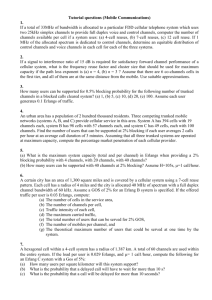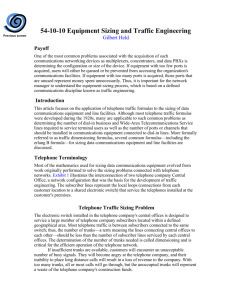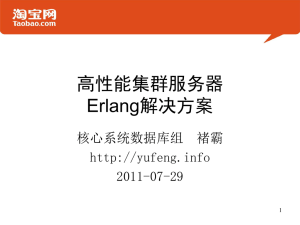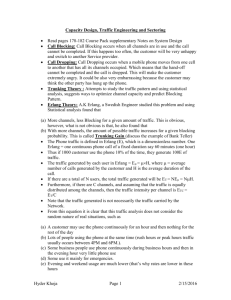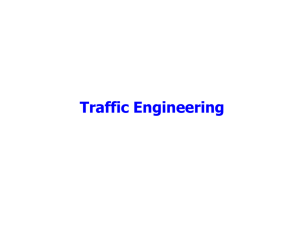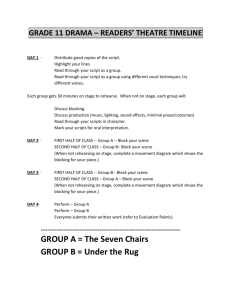Traffic Engineering
advertisement
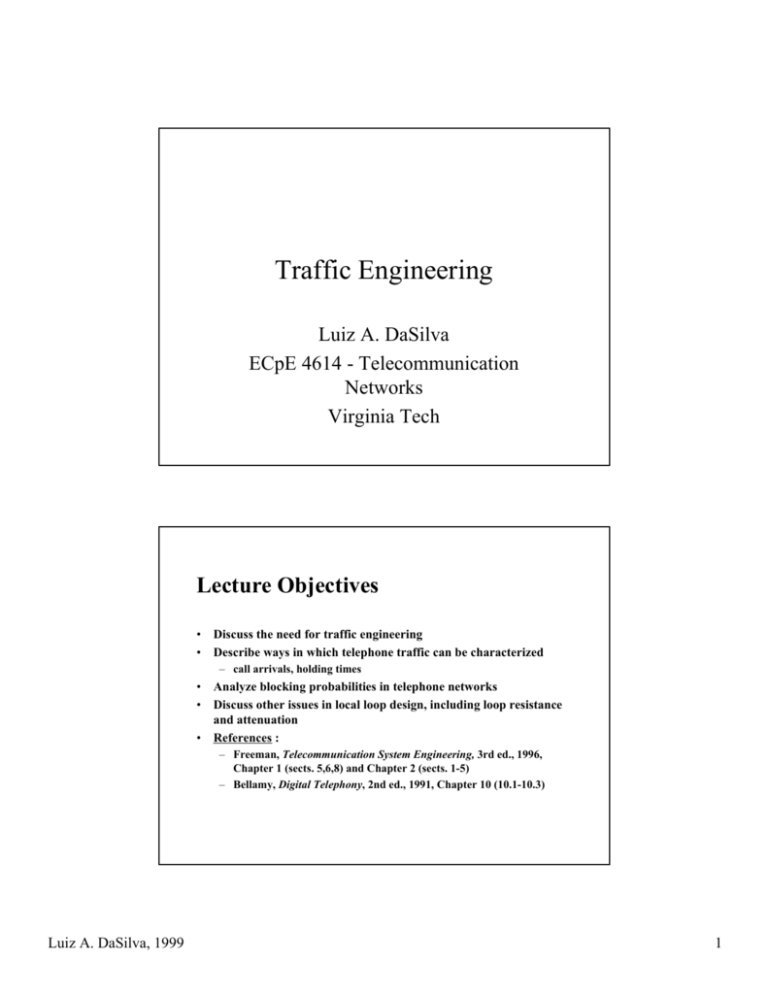
Traffic Engineering Luiz A. DaSilva ECpE 4614 - Telecommunication Networks Virginia Tech Lecture Objectives • Discuss the need for traffic engineering • Describe ways in which telephone traffic can be characterized – call arrivals, holding times • Analyze blocking probabilities in telephone networks • Discuss other issues in local loop design, including loop resistance and attenuation • References : – Freeman, Telecommunication System Engineering, 3rd ed., 1996, Chapter 1 (sects. 5,6,8) and Chapter 2 (sects. 1-5) – Bellamy, Digital Telephony, 2nd ed., 1991, Chapter 10 (10.1-10.3) Luiz A. DaSilva, 1999 1 Traffic Engineering • Performance analysis methods applied to telephony are usually referred to as traffic engineering • Steps – traffic characterization (calling patterns) – system modeling (queuing models, simulation) – analysis (blocking probability) • Design objectives – – – – Given expected traffic (+ growth assumptions)… Provision resources (trunks, switches)… To minimize cost … Subject to minimum acceptable quality of service requirements. Need for Provisioning (1) East Falls Church Central Office West Falls Church Trunk (n traffic paths) Central Office ... ... must Provisioning be done by telephone companies 50 subscribers 50 subscribers • • In the example, consider connection between 2 COs – n = 50 channels ensures no blocking, but too costly – n = 1 channel good cost option, but subscribers will be unhappy (high blocking probability) – how do we determine the appropriate compromise? Luiz A. DaSilva, 1999 2 Need for Provisioning (2) Alexandria m lines PSTN ... PBX ... Falls Church n lines PBX ... ... also Provisioning done by private businesses 50 users leased line 10 users • • In the example, a company has 2 offices – – – – n = 50, m = 10 : there’s never any blocking, but too costly n = 1, m = 1 : likely not enough, high blocking probability how do we get to a reasonable compromise? Leased lines used if traffic between two offices is high enough Traffic Characterization • Call arrivals – a random process • Call holding time – a random variable – duration of occupancy of a traffic path by a call • Traffic intensity not the same throughout the entire day – design decisions usually based on traffic intensity during the busy hour (worst case) • Busy hour is the 1-h period of the day during which traffic intensity is highest – CCITT : “The busy hour refers to the traffic volume or number of call attempts, and is that continuous 1-h period lying wholly in the time interval concerned for which this quantity is greatest.” Luiz A. DaSilva, 1999 3 Measurement of Telephone Traffic • Telephone traffic is the aggregate of telephone calls over a group of circuits or trunks with regard of the number and duration of calls. • We measure traffic intensity (A) as : A = λ tm , where – λ is the average arrival rate (ex., calls/hr) – tm is the average holding time (ex., hrs) • Units: – Erlangs (dimensionless) : calls-second per second – CCS : hundred (century) calls-second per hour – 1 erlang = (60)(60)/100 = 36 CCS • Capacity of a single channel is one erlang – Interpretation: a telephone that is busy 10% of the time represents a load of 0.1 erlang on that particular line • Example: 2 calls/hour with average holding time of 5 minutes – what is the traffic intensity in Erlangs? In CCS? Call Arrival Process • Basic assumption: arrivals are independent • Interarrival times – Only one arrival can occur during some small interval ∆t – The probability of an arrival is proportional to ∆t and is equal to λ∆t – The probability of an arrival in any given interval is independent of arrivals (or lack of arrivals) in any other interval – The times between arrivals are exponentially distributed with parameter λ • Poisson arrivals – good assumption if large # of independent sources, each with low arrival rate j t λt P( j arrivals during time t ) = Pj (λt ) = ( ) e− λ j! Luiz A. DaSilva, 1999 4 Holding Time Distribution • Two common assumptions – constant holding time – exponentially-distributed holding time • Constant holding time assumption – suitable for call setup, inter-office signaling, recorded message playback • Exponential holding time assumption – common model for conventional telephone use – tractable analysis due to memorylessness of exponential distribution (probability of a call termination independent of how long a call has been in progress) – probability that a holding time exceeds t: P(τ > t ) = e − t / t m Blocking and handling of lost calls • Grade of service (an estimate of blockage probability): Number of lost calls p= Number of offered calls • How are lost calls handled? – Lost calls held : user will immediately reattempt the call on receipt of a congestion signal – Lost calls cleared : user will hang up and wait some time interval before reattempting the call – Lost calls delayed : user is put in a queue, and waiting calls are handled FIFO (or LIFO, or randomly) Luiz A. DaSilva, 1999 5 Blocking Probability Example (1) • • • • Assume n phone trunks used to place a pool of calls Blocking occurs when a call arrives & all lines are in use Assume 1 Erlang of traffic, 5 minutes of avg holding time Represent the system through a state diagram – State Sj represents the case where there are j calls in progress – A continuous-time Markov process • Arrival rate = ___calls/min • Departure rate if n calls are in progress = ___ calls/min 0.2 S 0.2 S 0 0.2 S 1 0.2 S3 2 0.4 0.2 0.6 0.2 S4 0.8 S5 1.0 Blocking Probability Example (2) • Set up the balance equations 0 .2 p 4 = p 5 ⇒ p 4 = 5 p 5 0 . 2 p 3 + p 5 = p 4 ⇒ p 3 = 20 p 5 0 . 2 p 2 + 0 . 8 p 4 = 0 . 8 p 3 ⇒ p 2 = 60 p 5 0 . 2 p 1 + 0 . 6 p 3 = 0 . 6 p 2 ⇒ p 1 = 120 p 5 0 . 2 p 0 = 0 . 2 p 1 ⇒ p 0 = 120 p 5 ∑ 5 j=0 pj =1 • Solve the system of equations: – blocking probability = p0 = ________ Luiz A. DaSilva, 1999 6 Blocking Probability Example (3) • • • • • If a 1% maximum blocking probability is desired, we need 5 trunks These can be split into leased lines and dial lines connected to the PSTN Order the trunks – if a call comes into an empty system, it’s given to link 1 – if a call comes into a non-empty system, it’s given to the lowestnumbered link that is not busy (if all busy, call is blocked) What percentage of traffic is carried on link 1 ? – Repeat analysis pretending links 2-5 do not exist – Then p0 = 0.5 and so link 1 carries 50% of the traffic What percentage of traffic is carried on link 2 ? – Repeat analysis considering only links 1 and 2 – Then p0 = 0.2 and so links 1 and 2 carry 80% of the traffic – Therefore, link 2 carries 30% of the traffic Erlang B Formula (1) • Assumptions: – Poisson arrivals (infinite # of sources) – equal traffic density per source – lost calls cleared • Probability of blockage at the switch due to congestion or “all trunks busy”: An EB = n! Ax ∑ x = 0 x! n • A is the mean of the offered traffic [Erlangs], n is the number of trunks • Standardized by CCITT, widely adopted Luiz A. DaSilva, 1999 7 Erlang B Formula (2) Trunks P = .001 P = .005 P = .01 P = .05 1 5 .001 .76 .005 1.13 .01 1.36 .05 2.22 10 3.09 3.96 4.46 6.22 15 6.08 7.38 8.11 10.63 20 25 9.41 12.97 11.09 15 12.03 16.12 15.25 19.99 Example: Suppose our expected traffic in the busy hour is 10 erlangs and we require blocking probability of 1 call in 200 (or better). How many trunks should we use? Poisson Formula (1) • Assumptions: – infinite # of sources – equal traffic density per source – lost calls held • Probability of blockage at the switch due to congestion or “all trunks busy”: P=e −A ∞ ∑ x =n Ax x! • A = expected traffic density (busy hour erlangs), n = # of channels • Favored in U.S. Luiz A. DaSilva, 1999 8 Poisson Formula (2) Trunks P = .001 P = .01 P = .05 P = .1 1 5 .003 .75 .01 1.30 .05 1.95 .1 2.45 10 2.95 4.15 5.40 6.20 15 5.80 7.45 9.25 10.30 20 25 8.95 12.35 11.10 14.85 13.25 17.40 14.55 18.85 Example: Suppose our expected traffic in the busy hour is 10 erlangs and we require blocking probability of 1 call in 100 (or better). How many trunks should we use? Erlang C Formula • Assumptions: – infinite sources – exponentially-distributed holding times – lost calls delayed • Blocking probability given by An n P = n −1 nx ! n −n A A A n + ∑ n! n − A x =0 x! Luiz A. DaSilva, 1999 9 Dimensioning and Efficiency • Suppose 100 trunks between switches X and Y ⇒ upper limit of service on the route is 100 erlangs (maximum efficiency) – however, grade of service will not be acceptable • For P = .001, during the busy hour the trunks would be able to carry 75.24 erlangs (Erlang B formula) – excellent service grade, but phone company revenue will be significantly lower • Increase efficiency through alternative routing Z overflow traffic to Y via Z X direct route Y Other Issues in the Design of the Local Area Facilities • Local area includes subscriber plant, local exchanges, trunks connecting to these exchanges and trunks connecting the local area to the next level in the hierarchy or POP – telephone companies invest on avg more than 50% on local areas • Objective: to build the most economical local network assuming an established quality of service. • Issues: – geographic extension of local area of interest – number of inhabitants and telephone density – calling habits – business vs. residential phones – location of existing exchanges and extension of serving areas – present signalling/transmission characteristics Luiz A. DaSilva, 1999 10 Loop Length (I) D • For copper conductors, the loop resistance in ohms per mile is 0.1095 d2 where d is the diameter of the conductor (in inches) • Signaling resistance is one limiting parameter in designing the local loop Rdc = • Example: If we wish a 10-mi loop and allow 100Ω per mile of loop, what diameter of copper wire will be needed? Loop Length (II) Cable Gauge Loss/1000 ft (dB) 26 0.51 Ω/1000 ft of loop 83.5 24 0.41 51.9 22 0.32 32.4 19 0.21 16.1 • Attenuation or loop loss is another important factor • Attenuation on wire pair varies with inductance, capacitance, temperature (on open lines, attenuation may vary by ±12% between summer & winter) • Example: if we are limited to 6-dB loss on a subscriber loop, what is the maximum loop length permissible for 26-gauge wire? Luiz A. DaSilva, 1999 11 Lecture Summary • Traffic engineering is done by phone companies and businesses to achieve the desired tradeoff between cost and quality of service • Characterize telephone traffic by call arrival process and distribution of holding times • Calculating blocking probabilities: – For small number of links, feasible to analyze via balance equations for a Markov process – For infinite sources, LCC, Erlang B formula – For infinite sources, LCH, Poisson formula – For infinite sources, LCD, Erlang C formula • Other issues in local area design include loop resistance, location of exchanges, calling habits, etc. Luiz A. DaSilva, 1999 12
